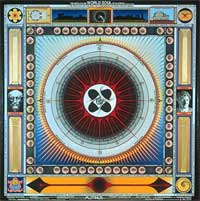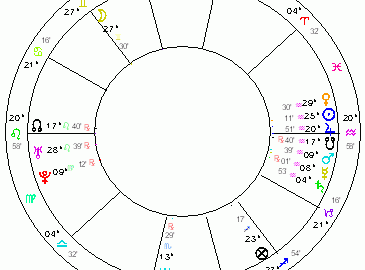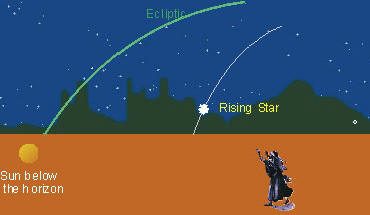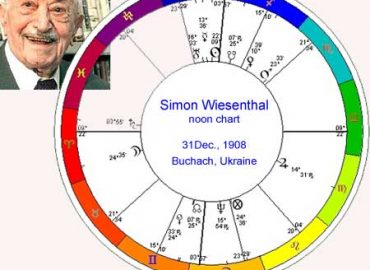Bernadette Brady
July 2006
The idea, desire and methodology of the ascent of the soul has been a predominant, ever-present theme in the thinking of humanity. From the Egyptian Pyramid text of the Old Kingdom (2650 – 2152 BCE) we see some of the first writings where the sky is considered to be divine and the soul, after death, moving upwards towards a perfect, immortal life.

I fly from you, oh men,
I am not for the earth.
I am for the sky.
I have soared to the sky as a heaven.
I have kissed the sky as a falcon.
I am the essence of a god,
The son of a god.
Behold the faithful and loving Osiris
Has come as the stars of Orion, the Beautiful One
I have come that I may glorify Orion.
My soul is a star of gold
And with him
I will traverse the sky forever. (Pyramid text )
Thousands of years later, Plato (c. 427–c. 347 BC) attempts to describe the soul’s ascent in The Republic in which he suggests that we live in a cave but that there is a brighter light outside which he defines as the World Soul, a great collective concept to which we all aspire or seek. Later the neo-Platonist, Plotinus (c. 205 – 270) expands Plato’s thinking by describing the soul in his Enneads when he talks of the moment of the heavens as being reflected in our own individual souls. He states that our personal souls have been captured and held down “by the clay it bears with it” while all the time “even in us the Spirit which dwells with the Soul does thus circle about the divinity. For since God is omnipresent, the Soul desiring perfect union must take the circular course: God is not stationed.” [Enneads, ii, 2]
Here Plotinus, like the earlier Egyptians, links the soul directly to the moment of the heavens and notes that our own individual souls mirror this moment in its desire to rejoin with the divine. These ideas have been carried through the ages but in twentieth century astrology there is little evidence of this long sky/earth/soul debate and the idea of soul as an entity has been defined in a more Jungian manner with the soul considered to be an archetype. This is described by James Hillman as “a perspective rather than a substance, a viewpoint toward things rather than a thing itself. . . .”[1] and thus contained within an astrological horoscope, like any other archetype, as an expression of the combination of planets, houses and signs.

But is this the only astrological approach to the question of soul? Is there any merit left in the ideas of the Egyptian ascent to the stars, and Plotinus’ linking of the moment of the heaven and the stars to the divine to which we aspire?
If your astrology is focused solely on the horoscope, you may well answer in the negative. However, if you are working with visual astrology, then you may have a vastly different approach to this question.
When we work with the dome of the starry sky we allow all the nuances of the visual phenomena of the sky to come into play in our astrological thinking. This methodology allows us to return to the earlier approaches to this important question of the Egyptians and of Plotinus. When we actually look at the sky it becomes obvious that, for the location of your birth, some stars are circumpolar, meaning they never set and are visible for the whole year. To the Egyptians such stars were deemed to be immortal and god-like if not gods themselves for they never travelled below the earth to the Underworld. However, sometimes one of these stars left the realm of the gods and came down to earth to spend time walking amongst the mortals. After a set period of days, this star would then leave the earth and return to the realm of the immortals. As it joined the earthy realms of the mortals, it becomes known as the Heliacal Setting star, meaning that it is seen to be setting on the western horizon just before sunrise.
Now there are many philosophical and theological implications of a star’s ability to move from the realm of the gods to the realm of humankind and then, after a time of “mortality”, ascend back to the gods. One of these implications is the idea of a saviour god who walks amongst us. However, let us focus on the implications which occur on a personal level.
Salvation in a Star
If you have your own parans from Starlight then have a look at your Heliacal Setting Star [found at the top of the paran printout listed just below the Heliacal Rising Star]. This star is the star which at the time of your birth was the god-like star walking upon the mortal earth. It is, in effect, the star whose mythology is reflective of your own sense of how you can reach for the divine, what you consider is your “higher” being, or “higher” purpose in life and what you hold sacred in your life. In short, this star’s mythology describes what you consider to be the nature of the pathway to your own salvation.
Now look to see if you have any stars listed as Curtailed Passage [this will be in red ink if you have a colour printer and is listed immediately after the star’s meaning]. Stars listed as Curtailed Passage are stars that, during the course of the year, descend and become the Heliacal Setting Star but at the time of your birth they are still totally in the realm of the immortals. Such stars when in paran to your natal planets act like intermediaries between your mortal world and your divine sense of being. They are the demi-gods or “saints” who show you the way to ascend to the gods. They act as role models and give you inspiration on the journey of your personal ascension, the ways and means towards the divine that you seek. They may not be open to “prayer” like a Christian saint, as they have left the earth, but they are examples of those who have made the ascent.
Here are a few examples.
Mohandas K Gandhi, 2 October, 1869, Porbander, India.
With his great personal dignity and total allegiance to non-violence, respect and love for others, Gandhi was a force so strong it overthrew British rule in India and gave his beloved nation independence. His guiding principal was love not violence, captured in many of his quotes, one of which is as follows:

Nonviolence and cowardice are contradictory terms.
Nonviolence is the greatest virtue, cowardice the greatest vice.
Nonviolence springs from love, cowardice from hate.
Nonviolence always suffers, cowardice would always inflict suffering.
Perfect nonviolence is the highest bravery.
Nonviolent conduct is never demoralizing, cowardice always is.
By his uncompromising non-violent approach, Gandhi eventually won the hearts of India, as well as the world. These are the stars from Gandhi’s chart that are his link to the divine (taken from Starlight’s paran printout).
HELIACAL SETTING STAR
Alderamin – Setting 09 mins 17 secs before Sunrise –
To use strength and dignity as the guiding principles of your life
PARANS (to planets)
Schedar as Moon is Setting orb 00 mins 39 secs –
A noble, religious or spiritual soul – Curtailed passage
Schedar as Sun is Culminating orb 00 mins 20 secs –
To have an honourable, or believable, charisma – Curtailed passage

Alderamin is the main star of Cepheus, the King, and in Starlight some of the delineation of this star are:
Gentle power, passive power. With this star in your chart, your skills are to be strongly focused but not aggressive. The greatest benefits and success will come by gentle determination rather than dramatic action.
However, as the Heliacal Setting Star, this great and ancient king star is linked with how Gandhi reaches for, or achieves what he believes to be his highest purpose. For Gandhi, strength and dignity is the pathway to his personal salvation, a pathway he also saw as the salvation of India.
Linked to this is another star which is in a phase of Curtailed passage and this is Schedar, the main star of Cassiopeia, the Queen. In Gandhi’s parans it is linked with both his natal Sun and Moon. In Starlight some of the delineations of this star are:
This star is the archetypal symbol of the queen. A natural ability to command respect, wisdom… This star demands dignity and rules by the power of respectability and honour. With it in your chart you can rely on your desire to always function with propriety, to treat others as you would like to be treated, to know that your dignity is the source of your power.
To have Schedar in a phase of Curtailed Passage and linked with both luminaries is a strong stellar emphasis on honour as a key to a person’s chosen pathway towards their own spiritual fulfilment. So for Gandhi, to travel the path with honour is one of his key principles. These stars then have to work in partnership with Gandhi’s natal chart but we can clearly see that a great deal of information can be gained by considering the stars that link Gandhi to the realm of the gods.
In contrast to the above example is:
Florence Nightingale – 12 May 1820, Florence, Italy 43N46, 11E15.

Florence Nightingale was the woman who became known as the “Lady with the Lamp” during the Crimea War (1854 – 56). Her Heliacal Setting star is Vindemiatrix, the great star in Virgo that collates and organises. After the war, where she set new standards in nursing, she devoted her life to reforming the nursing profession by developing new techniques of statistical analysis to prove her points and push through reforms. She kept records and analysed these records, proving to the military that care and cleanliness actually saved lives.
HELIACAL SETTING STAR
Vindemiatrix – Setting 22 mins 27 secs before Sunrise –
A collector, a person who seeks to complete things
PARANS
Arcturus as Saturn is Setting orb 01 mins 05 secs –
The engineer, the medical researcher, the explorer – the one who finds new pathways – Curtailed passage
Vega as Saturn is Rising orb 00 mins 38 secs –
A dominating person who can hold onto power – Curtailed passage
Vega as Venus is On Nadir orb 01 mins 37 secs –
The artist, visionary; ideas on social order – Curtailed passage
She also had two stars that were in a phase of Curtailed Passage while being in paran to her natal planets. The first is Arcturus which is the main star of Bootes, the great pathfinder, and some of the meanings as listed in Starlight are:
This is the star in the northern skies which bridges the lands between the hunter-gatherer nomad and the herder-cultivator-ploughman villager. Thus Arcturus embodies the symbolism of guarding, learning, teaching, leading. One who can lead the way, one who has the vision or the spirit to take the first step. …
This star acts as a role model, a personal mentor, so now she not only has to collate and develop new idea on nursing but now she must teach it to others.
Florence also has Vega in curtailed passage and in paran to two planets. This is a star of charisma or persuasion and it is the main star of the Lyra, the constellation which is symbolic of the magic of music, so it indicates her personal ability to convince others to follow her chosen pathway.
Researching the theme
I like to use Starlight to scan for stars in a particular phase in a person’s chart as I find this a good technique for getting the “feel” for a specific star/planet/phase configuration. For example, other people who had Arcturus, the great path finding star, in paran with their natal Saturn while also being in a phase of Curtailed Passage were:
Frederic-Auguste Bartholdi, 2 April 1834 NS 12:00 LMT -00:29:28 Colmar, France 48°N05′ 07°E22′ Bartholdi was the French sculptor of the Statue of Liberty in New York Harbor.
Sir Hans Sloane, 16 April 1606 NS 12:00 LMT +00:22:52 Killyleagh, United Kingdom 54°N24′ 05°W43′ Sloane was a physician and naturalist whose collection of manuscripts, curiosities, specimens and books formed the basis for the British Museum. He studied medicine and obtained his degree in 1683. He travelled widely and while in Jamaica collected more than 800 new species of plants that were published in a catalogue in 1696
V.I. Lenin, 21 April 1870 20:46:24 UT +00:00 Simbirsk, Russia 54°N20′ 48°E24′ , founder of a new pathway for Russia.
These are simple examples which start to give us insights into the role that the Heliacal Setting Star and stars in a phase of Curtailed Passage can play in giving us understanding of how we personally seek our salvation, how we personally reach out for the divine. Such stars, when married to the meanings of the planets, reveal deep principles in our lives, the things in which we believe, the way we want to live, the deep spiritual goals that we seek to fulfill.
By ignoring star phases astrology has become blind to this ancient and mystical journey that is played out in each of our own charts – the ascent and descend of the soul and how we reach up and touch the divine.
[1] Hillman, James (1975). Re-visioning Psychology. New York: Harper and Row.




